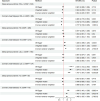Assessing the effects of HMGCR, LPL, and PCSK9 inhibition on sleep apnea: Mendelian randomization analysis of drug targets
- PMID: 39470521
- PMCID: PMC11520985
- DOI: 10.1097/MD.0000000000040194
Assessing the effects of HMGCR, LPL, and PCSK9 inhibition on sleep apnea: Mendelian randomization analysis of drug targets
Abstract
To investigate the use of lipid-lowering drugs and abnormal serum lipid levels in patients at risk of sleep apnea syndrome. Three types of Mendelian randomization (MR) analyses were used. First, a 2-sample Mendelian randomization (TSMR) analysis was used to investigate the association between sleep apnea syndrome risk and serum lipid levels. Multivariate Mendelian randomization (MVMR) analysis was subsequently used to investigate the effects of confounding variables on SAS incidence of sleep apnea syndrome. Finally, drug-target Mendelian randomization (DMR) analysis was used to analyze the association between lipid-lowering drug use and sleep apnea syndrome risk. According to the TSMR analysis, the serum HDL-C concentration was negatively correlated with sleep apnea syndrome (OR = 0.904; 95% CI = 0.845-0.967; P = .003). Serum TG levels were positively correlated with sleep apnea syndrome (OR = 1.081; 95% CI = 1.003-1.163; P = .039). The association between serum HDL-C levels and sleep apnea syndrome in patients with MVMR was consistent with the results in patients with TSMR (OR = 0.731; 95% CI = 0.500-1.071; P = 3.94E-05). According to our DMR analysis, HMGCR and PCSK9, which act by lowering serum LDL-C levels, were inversely associated with the risk of sleep apnea syndrome (OR = 0.627; 95% CI = 0.511-0.767; P = 6.30E-06) (OR = 0.775; 95% CI = 0.677-0.888; P = .0002). LPL, that lowered serum TG levels, was positively associated with the risk of sleep apnea syndrome (OR = 1.193; 95% CI = 1.101-1.294; P = 1.77E-05). Our analysis suggested that high serum HDL-C levels may reduce the risk of sleep apnea syndrome. Low serum TG levels have a protective effect against sleep apnea syndrome. The DMR results suggested that the use of HMGCR lipid-lowering drugs (such as statins) and PCSK9 inhibitors has a protective effect against sleep apnea syndrome. However, LPL-based lipid-lowering drugs may increase the risk of sleep apnea syndrome.
Copyright © 2024 the Author(s). Published by Wolters Kluwer Health, Inc.
Figures




Similar articles
-
Genetic association of lipids and lipid lowering drug target genes with sarcoidosis.Sci Rep. 2024 Oct 17;14(1):24351. doi: 10.1038/s41598-024-75322-3. Sci Rep. 2024. PMID: 39420052 Free PMC article.
-
Lipids, lipid-lowering drugs and the risk of herpes zoster: a Mendelian randomization study.Arch Dermatol Res. 2025 Jan 4;317(1):166. doi: 10.1007/s00403-024-03600-1. Arch Dermatol Res. 2025. PMID: 39755897
-
Exploring the causal effect between lipid-modifying drugs and idiopathic pulmonary fibrosis: a drug-target Mendelian randomization study.Lipids Health Dis. 2024 Aug 1;23(1):237. doi: 10.1186/s12944-024-02218-6. Lipids Health Dis. 2024. PMID: 39090671 Free PMC article.
-
Genetic Association of Lipids and Lipid Drug Targets With Abdominal Aortic Aneurysm: A Meta-analysis.JAMA Cardiol. 2018 Jan 1;3(1):26-33. doi: 10.1001/jamacardio.2017.4293. JAMA Cardiol. 2018. PMID: 29188294 Free PMC article. Review.
-
Leveraging drug-target Mendelian randomization for tailored lipoprotein-lipid lowering.Curr Opin Lipidol. 2025 Apr 1;36(2):71-77. doi: 10.1097/MOL.0000000000000977. Epub 2025 Feb 20. Curr Opin Lipidol. 2025. PMID: 39973804 Review.
References
-
- Lyons MM, Bhatt NY, Pack AI, Magalang UJ. Global burden of sleep-disordered breathing and its implications. Respirology. 2020;25:690–702. - PubMed
-
- Drazen JM. Sleep apnea syndrome. N Engl J Med. 2002;346:390. - PubMed
-
- Shokoueinejad M, Fernandez C, Carroll E, et al. . Sleep apnea: a review of diagnostic sensors, algorithms, and therapies. Physiol Meas. 2017;38:R204–52. - PubMed
-
- Wang T, Yang J, Song Y, Pang F, Guo X, Luo Y. Interactions of central and autonomic nervous systems in patients with sleep apnea-hypopnea syndrome during sleep. Sleep Breath. 2022;26:621–31. - PubMed
-
- Gündüz C, Basoglu OK, Hedner J, et al. . European Sleep Apnea Database Collaborators. Obstructive sleep apnoea independently predicts lipid levels: data from the European Sleep Apnea Database. Respirology. 2018;23:1180–9. - PubMed
MeSH terms
Substances
LinkOut - more resources
Full Text Sources
Medical
Miscellaneous

